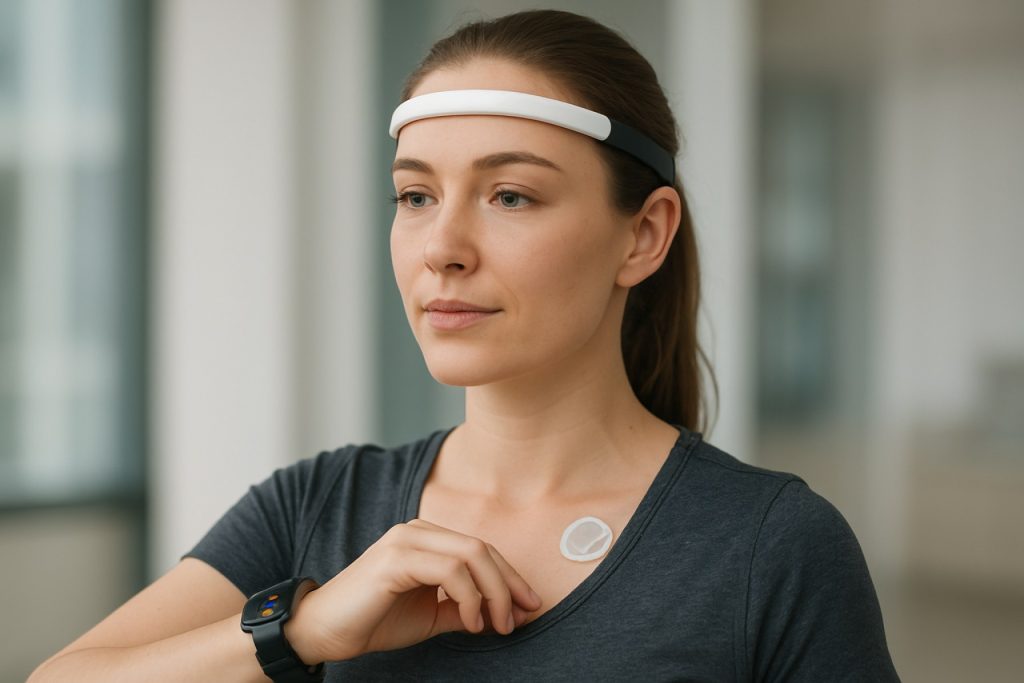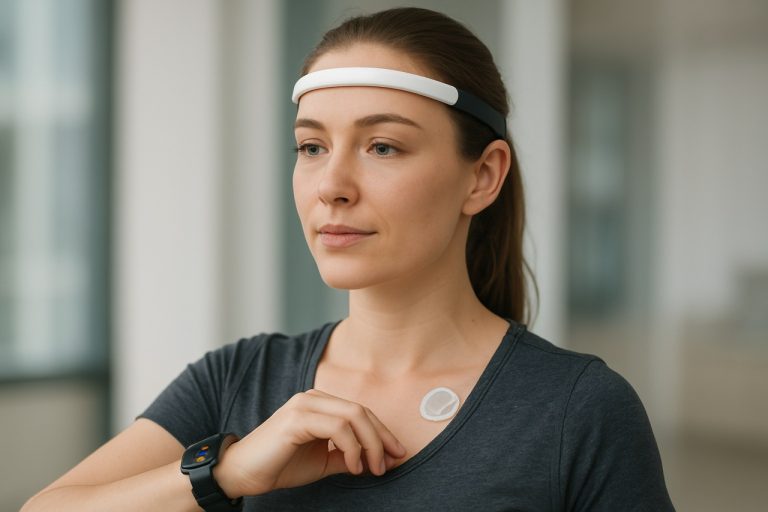
Biofeedback Wearable Technology Development in 2025: Unleashing the Next Wave of Personalized Health and Performance Optimization. Explore the Innovations, Market Forces, and Future Trajectories Shaping This Transformative Sector.
- Executive Summary: Key Trends and Market Drivers in 2025
- Market Size, Growth Forecasts, and Regional Hotspots (2025–2030)
- Core Technologies: Sensors, Algorithms, and Data Integration
- Leading Players and Strategic Partnerships (Citing Official Company Sources)
- Emerging Applications: Healthcare, Sports, Mental Wellness, and Beyond
- Regulatory Landscape and Industry Standards (Referencing Industry Bodies)
- User Experience, Data Privacy, and Security Innovations
- Investment, M&A, and Startup Ecosystem Developments
- Challenges, Barriers, and Solutions for Mass Adoption
- Future Outlook: Disruptive Innovations and Long-Term Impact
- Sources & References
Executive Summary: Key Trends and Market Drivers in 2025
The biofeedback wearable technology sector is experiencing rapid evolution in 2025, driven by advances in sensor miniaturization, artificial intelligence (AI), and growing consumer demand for personalized health insights. Biofeedback wearables—devices that monitor physiological signals such as heart rate variability, skin temperature, electrodermal activity, and brainwave patterns—are increasingly being integrated into daily life for health, wellness, and clinical applications.
A key trend in 2025 is the convergence of multi-sensor platforms, enabling more comprehensive and accurate monitoring. Leading manufacturers such as Apple Inc. and Garmin Ltd. have expanded their wearable offerings to include advanced biofeedback features, such as continuous ECG, SpO2, and stress tracking. Apple Inc.’s latest Apple Watch models, for example, now incorporate real-time stress detection and sleep stage analysis, leveraging machine learning algorithms for actionable feedback.
Another significant driver is the integration of biofeedback wearables into clinical and therapeutic settings. Companies like Empatica Inc. and Neurosteer Ltd. are collaborating with healthcare providers to deploy FDA-cleared devices for epilepsy monitoring, mental health assessment, and neurorehabilitation. These partnerships are accelerating regulatory acceptance and expanding reimbursement pathways, making biofeedback wearables more accessible for patients and clinicians.
The proliferation of open APIs and interoperability standards is also shaping the market. Device makers are increasingly supporting integration with electronic health records (EHRs) and third-party health platforms, as seen with Fitbit (now part of Google LLC) and Withings SA. This trend is fostering a more connected health ecosystem, enabling longitudinal tracking and personalized interventions.
Looking ahead, the next few years are expected to see further miniaturization, improved battery life, and the emergence of non-invasive biochemical sensors capable of tracking hydration, glucose, and other biomarkers. Startups and established players alike are investing in research and development to bring these innovations to market. The sector is also witnessing increased attention to data privacy and security, with companies implementing end-to-end encryption and user-controlled data sharing protocols.
In summary, the biofeedback wearable technology market in 2025 is characterized by technological convergence, clinical integration, and a focus on user-centric design. As the sector matures, it is poised to play a pivotal role in preventive health, chronic disease management, and mental wellness, supported by ongoing innovation from industry leaders and emerging disruptors.
Market Size, Growth Forecasts, and Regional Hotspots (2025–2030)
The global market for biofeedback wearable technology is poised for robust growth between 2025 and 2030, driven by increasing consumer interest in health optimization, stress management, and chronic disease monitoring. Biofeedback wearables—devices that monitor physiological signals such as heart rate variability, skin temperature, electrodermal activity, and brainwave patterns—are becoming more sophisticated and accessible, expanding their reach beyond clinical settings into everyday consumer use.
Major industry players are investing heavily in research and development to enhance sensor accuracy, miniaturization, and user experience. Apple Inc. continues to lead with its Apple Watch, which integrates heart rate, blood oxygen, and ECG monitoring, and is rumored to be exploring non-invasive blood glucose tracking and advanced stress detection features for future iterations. Garmin Ltd. and Fitbit (now part of Google LLC) are also expanding their biofeedback capabilities, focusing on sleep quality, stress, and recovery metrics. Meanwhile, Whoop, Inc. has gained traction among athletes and wellness enthusiasts with its subscription-based wearable that provides continuous physiological monitoring and actionable feedback.
The market is expected to see a compound annual growth rate (CAGR) in the double digits through 2030, with North America and Europe remaining the largest markets due to high consumer awareness, established healthcare infrastructure, and favorable regulatory environments. However, Asia-Pacific is emerging as a significant growth hotspot, fueled by rising disposable incomes, urbanization, and increasing adoption of digital health technologies. Companies such as Xiaomi Corporation and Huawei Technologies Co., Ltd. are making biofeedback wearables more affordable and accessible in these regions, contributing to rapid market expansion.
In addition to consumer wellness, the integration of biofeedback wearables into telemedicine and remote patient monitoring is accelerating, particularly in the United States and parts of Europe. Partnerships between device manufacturers and healthcare providers are expected to proliferate, enabling more personalized and data-driven care. Regulatory bodies such as the U.S. Food and Drug Administration (FDA) are increasingly providing clear pathways for the approval of medical-grade biofeedback devices, further supporting market growth.
Looking ahead, the convergence of artificial intelligence, cloud computing, and advanced biosensors is set to drive innovation in the sector. As privacy and data security concerns are addressed, and as interoperability standards improve, biofeedback wearables are likely to become an integral part of preventive healthcare and lifestyle management worldwide.
Core Technologies: Sensors, Algorithms, and Data Integration
The development of biofeedback wearable technology in 2025 is characterized by rapid advancements in core technologies, particularly in sensor innovation, algorithm sophistication, and seamless data integration. These elements collectively underpin the accuracy, reliability, and user experience of modern biofeedback devices.
Sensor technology remains at the heart of biofeedback wearables. In 2025, leading manufacturers are deploying multi-modal sensor arrays capable of capturing a wide range of physiological signals, including heart rate variability, electrodermal activity, skin temperature, and muscle activity (EMG). Companies such as Empatica and Garmin are integrating advanced photoplethysmography (PPG), electrocardiogram (ECG), and inertial measurement units (IMUs) into compact, energy-efficient form factors. Empatica, for example, has focused on medical-grade sensors for continuous monitoring, while Garmin leverages its expertise in sports and wellness to deliver robust, multi-sensor platforms.
Algorithm development is equally critical. In 2025, biofeedback wearables increasingly utilize machine learning and artificial intelligence to interpret complex biosignals in real time. These algorithms filter noise, detect anomalies, and personalize feedback based on individual baselines. Apple continues to refine its proprietary algorithms for the Apple Watch, enabling features such as irregular rhythm notifications and stress monitoring. Meanwhile, Fitbit (now part of Google) employs adaptive algorithms to provide actionable insights on sleep, stress, and recovery, leveraging large-scale anonymized datasets to improve accuracy and relevance.
Data integration is a defining trend for 2025 and beyond. Wearable devices are increasingly interoperable with smartphones, cloud platforms, and electronic health records, enabling a holistic view of user health. Withings and Polar are notable for their open APIs and partnerships with digital health platforms, facilitating seamless data exchange and third-party app development. Secure, real-time data synchronization allows users and healthcare providers to access longitudinal health data, supporting preventive care and remote monitoring.
Looking ahead, the convergence of miniaturized sensors, advanced algorithms, and integrated data ecosystems is expected to drive further innovation in biofeedback wearables. The focus will likely shift toward greater personalization, predictive analytics, and clinical validation, as companies seek to expand applications from wellness into regulated healthcare environments.
Leading Players and Strategic Partnerships (Citing Official Company Sources)
The biofeedback wearable technology sector in 2025 is characterized by rapid innovation, with leading players leveraging strategic partnerships to accelerate product development, expand market reach, and integrate advanced biosensing capabilities. Major technology and healthcare companies are collaborating with research institutions, component manufacturers, and digital health platforms to create next-generation wearables that provide real-time physiological feedback for health, wellness, and medical applications.
Among the most prominent companies, Apple Inc. continues to lead with its Apple Watch series, which incorporates advanced sensors for heart rate, blood oxygen, and ECG monitoring. Apple’s ongoing collaborations with academic medical centers and healthcare providers are aimed at validating new biofeedback features and expanding clinical applications. The company’s HealthKit and ResearchKit frameworks further enable integration with third-party biofeedback devices and research studies.
Another key player, Fitbit (now part of Google LLC), has maintained its position through continuous innovation in wearable biosensors and data analytics. Fitbit’s partnerships with health systems and insurers focus on leveraging biofeedback data for chronic disease management and preventive care. The company’s open API ecosystem encourages third-party developers to create new biofeedback-driven applications, enhancing the platform’s versatility.
In the medical-grade wearable segment, Medtronic stands out for its development of implantable and wearable devices that provide real-time feedback for cardiac and neurological conditions. Medtronic’s collaborations with hospitals and digital health startups are driving the integration of biofeedback data into remote patient monitoring and telehealth platforms.
Emerging players such as Wearable Technologies AG are fostering industry-wide partnerships, acting as a hub for startups, component suppliers, and established brands to co-develop interoperable biofeedback solutions. Their annual conferences and innovation programs facilitate knowledge exchange and joint ventures across the wearable technology ecosystem.
Strategic alliances are also evident in the sports and wellness sector. Garmin Ltd. has expanded its biofeedback capabilities through partnerships with sports science institutes and fitness platforms, enabling advanced metrics such as heart rate variability, stress tracking, and sleep analysis. These collaborations are crucial for validating sensor accuracy and developing personalized coaching algorithms.
Looking ahead, the next few years are expected to see deeper integration between biofeedback wearables and digital health records, driven by partnerships between device manufacturers, healthcare providers, and cloud computing companies. The convergence of biosensing, artificial intelligence, and secure data sharing will likely define the competitive landscape, with leading players investing heavily in R&D and cross-sector alliances to maintain their edge in the evolving biofeedback wearable market.
Emerging Applications: Healthcare, Sports, Mental Wellness, and Beyond
The development of biofeedback wearable technology is accelerating rapidly in 2025, with significant advancements and expanding applications across healthcare, sports, mental wellness, and other sectors. These devices, which monitor physiological signals and provide real-time feedback to users, are increasingly sophisticated, leveraging advances in sensor miniaturization, wireless connectivity, and artificial intelligence.
In healthcare, biofeedback wearables are being integrated into chronic disease management and rehabilitation programs. Devices such as continuous glucose monitors and ECG patches are now more accurate and user-friendly, enabling patients and clinicians to track vital signs and intervene proactively. Companies like Abbott and Medtronic are at the forefront, offering FDA-cleared solutions for diabetes and cardiac care. Additionally, startups are introducing multi-sensor platforms that combine heart rate, skin temperature, and electrodermal activity to support remote patient monitoring and telemedicine.
In sports and fitness, biofeedback wearables are transforming training regimens and injury prevention. Leading brands such as Garmin and Polar have expanded their product lines to include advanced metrics like heart rate variability, muscle oxygen saturation, and real-time movement analysis. These insights help athletes optimize performance and recovery, while also providing coaches with actionable data. The integration of AI-driven analytics is expected to further personalize training programs in the coming years.
Mental wellness is another area experiencing rapid growth. Wearables that monitor stress indicators—such as heart rate variability and skin conductance—are being adopted for mindfulness, meditation, and stress management. Companies like Fitbit (now part of Google) and EMOTIV are developing devices that provide users with real-time feedback on their mental state, encouraging healthier habits and early intervention for anxiety or burnout. The convergence of biofeedback with digital therapeutics is anticipated to expand, offering new tools for behavioral health.
Beyond these core sectors, biofeedback wearables are finding applications in workplace safety, sleep optimization, and even gaming. For example, industrial wearables can alert workers to signs of fatigue or dehydration, while sleep trackers from companies like Withings are being used in clinical sleep studies. As sensor technology continues to evolve and regulatory pathways become clearer, the next few years are likely to see broader adoption and new use cases, driven by partnerships between device manufacturers, healthcare providers, and technology firms.
Regulatory Landscape and Industry Standards (Referencing Industry Bodies)
The regulatory landscape for biofeedback wearable technology is rapidly evolving as these devices become more integrated into healthcare, wellness, and consumer markets. In 2025, regulatory agencies and industry bodies are intensifying their focus on safety, efficacy, data privacy, and interoperability standards to keep pace with technological advancements and increased adoption.
In the United States, the U.S. Food and Drug Administration (FDA) continues to play a central role in the oversight of biofeedback wearables, particularly those intended for medical use. The FDA’s Digital Health Center of Excellence is actively updating guidance on software as a medical device (SaMD) and wearable sensors, emphasizing risk-based classification and streamlined premarket review for low- to moderate-risk devices. In 2024 and 2025, the FDA has expanded its Digital Health Software Precertification Program, aiming to accelerate the approval process for innovative biofeedback solutions while maintaining rigorous safety standards.
In Europe, the European Medicines Agency (EMA) and the European Committee for Standardization (CEN) are harmonizing regulations under the Medical Device Regulation (MDR) framework. The MDR, fully enforced since 2021, requires comprehensive clinical evaluation and post-market surveillance for wearable medical devices, including those with biofeedback capabilities. CEN, together with the International Organization for Standardization (ISO), is developing new standards for wearable sensor accuracy, interoperability, and cybersecurity, with several working groups targeting updates in 2025 and beyond.
Globally, the Institute of Electrical and Electronics Engineers (IEEE) is a key player in establishing technical standards for biofeedback wearables. The IEEE 11073 Personal Health Data (PHD) standards are being updated to address new sensor modalities and data exchange protocols, supporting seamless integration with electronic health records and telemedicine platforms. The Bluetooth Special Interest Group (Bluetooth SIG) is also advancing specifications for secure, low-power wireless communication, which is critical for continuous biofeedback monitoring.
Industry alliances such as the Continua Health Alliance (now part of the Personal Connected Health Alliance) are promoting interoperability and certification programs to ensure that devices from different manufacturers can work together reliably. These efforts are expected to accelerate in 2025 as the market for biofeedback wearables expands into remote patient monitoring, mental health, and sports performance.
Looking ahead, regulatory convergence and the adoption of international standards are anticipated to streamline global market access for biofeedback wearables. However, ongoing challenges remain in balancing innovation with patient safety, data protection, and ethical considerations, making the role of industry bodies and regulators more critical than ever in the coming years.
User Experience, Data Privacy, and Security Innovations
The rapid evolution of biofeedback wearable technology in 2025 is marked by a strong focus on user experience, data privacy, and security innovations. As wearables become more sophisticated, integrating advanced sensors for real-time physiological monitoring, leading manufacturers are prioritizing seamless user interfaces and robust data protection frameworks.
User experience (UX) is at the forefront of product development. Companies such as Apple Inc. and Garmin Ltd. are refining their wearable platforms to deliver intuitive, personalized feedback. The latest iterations of devices like the Apple Watch and Garmin’s Venu series offer adaptive notifications, haptic feedback, and AI-driven insights, making biofeedback actionable and accessible for users of all ages and technical backgrounds. These enhancements are supported by continuous software updates and ecosystem integration, ensuring that users can interact with their health data across multiple devices and services.
Data privacy and security have become central concerns as wearables collect increasingly sensitive biometric information. In 2025, industry leaders are implementing end-to-end encryption and on-device data processing to minimize exposure of personal health data. Fitbit (now part of Google) has introduced enhanced privacy controls, allowing users to manage data sharing preferences and access transparency reports. Similarly, Samsung Electronics has expanded its Knox security platform to cover wearable devices, providing hardware-level protection and secure data storage.
Regulatory compliance is shaping the development landscape. Companies are aligning with evolving standards such as the European Union’s General Data Protection Regulation (GDPR) and the United States’ Health Insurance Portability and Accountability Act (HIPAA). This is driving the adoption of privacy-by-design principles, where data minimization and user consent are embedded into device architecture from the outset. Industry bodies like the Bluetooth Special Interest Group are also updating wireless communication protocols to address vulnerabilities specific to health data transmission.
Looking ahead, the next few years will likely see further integration of biometric authentication, such as ECG-based user identification, and the use of decentralized data storage models. Partnerships between device manufacturers and cloud service providers are expected to yield new solutions for secure, user-controlled data sharing. As biofeedback wearables become more prevalent in clinical and consumer settings, the balance between usability and privacy will remain a defining challenge and innovation driver for the sector.
Investment, M&A, and Startup Ecosystem Developments
The biofeedback wearable technology sector is experiencing robust investment activity and dynamic startup formation as of 2025, driven by advances in sensor miniaturization, AI-powered analytics, and growing demand for personalized health monitoring. Venture capital and corporate investment are fueling both established players and emerging startups, with a focus on expanding applications from wellness and fitness to clinical-grade health management.
In recent years, major wearable manufacturers such as Apple Inc. and Garmin Ltd. have increased R&D spending and made strategic acquisitions to enhance their biofeedback capabilities. Apple Inc. continues to integrate advanced biosensors into its Apple Watch line, with recent models featuring blood oxygen, ECG, and temperature sensors, and ongoing research into non-invasive glucose monitoring. Garmin Ltd. has expanded its portfolio with wearables that track heart rate variability, stress, and sleep, targeting both consumer and professional health markets.
The startup ecosystem is particularly vibrant, with companies like Whoop, Inc. and Oura Health Oy raising significant funding rounds to scale production and develop new features. Whoop, Inc. has attracted attention for its subscription-based model and partnerships with sports organizations, while Oura Health Oy has expanded its global reach through collaborations with research institutions and integration with third-party health platforms.
Mergers and acquisitions are shaping the competitive landscape. In 2024, Fitbit LLC (a subsidiary of Google LLC) acquired a European biosensor startup to accelerate the development of next-generation health wearables. Meanwhile, BioTelemetry, Inc. (now part of Koninklijke Philips N.V.) continues to integrate remote patient monitoring solutions, signaling a convergence between consumer wearables and regulated medical devices.
Investment is also flowing into specialized startups targeting mental health and neurofeedback, such as InteraXon Inc. (Muse), which develops EEG headbands for meditation and cognitive training. These companies are attracting both venture capital and strategic partnerships with healthcare providers, reflecting a broader trend toward holistic health monitoring.
Looking ahead, the sector is expected to see continued consolidation as larger technology and healthcare firms seek to acquire innovative startups to bolster their biofeedback capabilities. The influx of capital and strategic alliances is likely to accelerate the pace of innovation, with a focus on clinical validation, interoperability, and expansion into new therapeutic areas. As regulatory frameworks evolve and reimbursement models adapt, biofeedback wearables are poised to play a central role in the future of personalized and preventive healthcare.
Challenges, Barriers, and Solutions for Mass Adoption
The mass adoption of biofeedback wearable technology in 2025 faces a complex landscape of challenges and barriers, even as the sector continues to innovate rapidly. One of the primary hurdles is data accuracy and reliability. Many current-generation wearables, such as those developed by Garmin and Fitbit, have made significant strides in tracking physiological signals like heart rate, skin temperature, and electrodermal activity. However, ensuring clinical-grade precision outside controlled environments remains a challenge, particularly for metrics such as blood pressure and stress levels. This limitation can hinder trust among healthcare professionals and end-users, slowing integration into medical and wellness routines.
Another significant barrier is data privacy and security. As biofeedback devices collect sensitive biometric information, concerns over data breaches and misuse are prominent. Companies like Apple have responded by implementing on-device processing and end-to-end encryption for health data, but regulatory frameworks are still evolving to keep pace with technological advancements. The introduction of stricter data protection regulations in regions such as the European Union and the United States is expected to shape product development and user consent mechanisms in the coming years.
Interoperability and standardization also present obstacles. The lack of universal standards for data formats and device communication complicates integration with electronic health records and third-party health platforms. Industry groups and manufacturers, including Samsung and Withings, are increasingly collaborating to develop open APIs and compatibility protocols, but widespread adoption is still in progress.
User engagement and sustained usage represent further challenges. While initial adoption rates are high, long-term retention often declines due to device fatigue, perceived complexity, or limited actionable insights. Companies are addressing this by enhancing user interfaces, personalizing feedback, and integrating AI-driven coaching, as seen in recent updates from Polar and Oura Health.
To overcome these barriers, the industry is focusing on several solutions. Advances in sensor miniaturization and flexible electronics are improving comfort and wearability, while partnerships with healthcare providers are validating device efficacy in clinical settings. Additionally, ongoing efforts to educate consumers about the benefits and limitations of biofeedback wearables are expected to foster greater trust and adoption. As these solutions mature, the outlook for mass adoption in the next few years appears increasingly promising, with a convergence of technological, regulatory, and user-centric innovations driving the sector forward.
Future Outlook: Disruptive Innovations and Long-Term Impact
The future of biofeedback wearable technology in 2025 and the coming years is poised for significant transformation, driven by advances in sensor miniaturization, artificial intelligence (AI), and integration with digital health ecosystems. As the demand for personalized health monitoring grows, biofeedback wearables are expected to move beyond traditional fitness tracking to deliver real-time, actionable insights for stress management, chronic disease monitoring, and mental health support.
Key industry players are accelerating innovation in this space. Apple Inc. continues to expand the health capabilities of its Apple Watch, with ongoing research into non-invasive blood glucose monitoring and advanced stress detection. The company’s focus on privacy and seamless integration with its HealthKit platform positions it as a leader in consumer biofeedback wearables. Similarly, Garmin Ltd. is enhancing its wearables with features such as heart rate variability (HRV) tracking and sleep analytics, targeting both athletes and general wellness users.
Emerging companies are also shaping the landscape. Whoop, Inc. has gained traction with its subscription-based model, offering continuous physiological monitoring and personalized coaching for recovery and performance. Their device, which tracks metrics like HRV, respiratory rate, and skin temperature, is increasingly used by professional athletes and corporate wellness programs. Meanwhile, Empatica Srl is advancing medical-grade wearables, with FDA-cleared devices for seizure detection and research into stress and sleep disorders.
On the technology front, the integration of AI and machine learning is expected to enable more sophisticated interpretation of biofeedback data, allowing wearables to provide predictive analytics and early warnings for health events. Companies such as Fitbit LLC (now part of Google) are investing in algorithms that can detect arrhythmias, sleep apnea, and other conditions, with the goal of supporting preventive healthcare.
Looking ahead, the convergence of biofeedback wearables with telemedicine and remote patient monitoring platforms is likely to disrupt traditional healthcare delivery. Partnerships between device manufacturers and healthcare providers are anticipated to expand, enabling continuous patient monitoring and data-driven interventions. Regulatory bodies are also expected to play a crucial role, as the line between consumer wellness devices and medical-grade wearables becomes increasingly blurred.
In summary, the next few years will see biofeedback wearables evolve from lifestyle accessories to essential tools for proactive health management, with disruptive innovations in sensor technology, AI-driven analytics, and healthcare integration shaping the long-term impact of this sector.
Sources & References
- Apple Inc.
- Empatica Inc.
- Fitbit (now part of Google LLC)
- Withings SA
- Whoop, Inc.
- Huawei Technologies Co., Ltd.
- Polar
- Medtronic
- Wearable Technologies AG
- Medtronic
- Polar
- Fitbit
- Withings
- European Medicines Agency
- European Committee for Standardization (CEN)
- International Organization for Standardization
- Institute of Electrical and Electronics Engineers
- Bluetooth Special Interest Group
- Google LLC
- Koninklijke Philips N.V.



